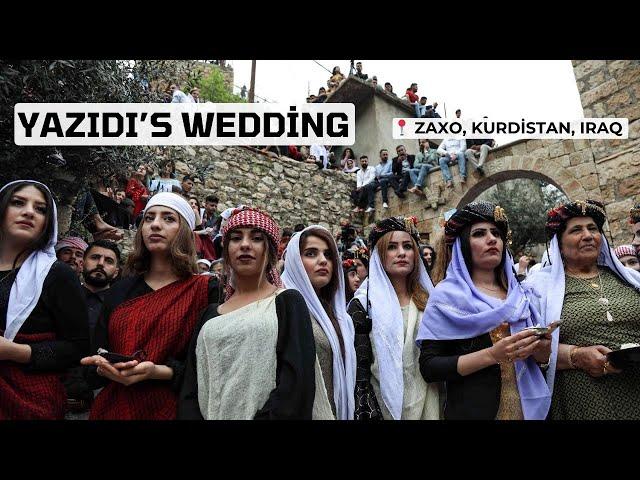
Yazidi's Wedding Ceremony I Kurdistan, Iraq I 4K60FPS
Yazīdī, member of a Kurdish religious minority found primarily in northern Iraq, southeastern Turkey, northern Syria, the Caucasus region, and parts of Iran. The Yazīdī religion includes elements of ancient Iranian religions as well as elements of Judaism, Nestorian Christianity, and Islam. Although scattered and probably numbering only between 200,000 and 1,000,000, the Yazīdīs have a well-organized society, with a chief sheikh as the supreme religious head and an emir, or prince, as the secular head.
The origins of the name Yazīdī are uncertain; some scholars have proposed that it comes from the Old Iranian yazata (divine being), while others hold that it derives from the name of the Umayyad caliph Yazīd I, who is venerated by Yazīdīs.
The origins of the Yazīdī faith can be traced to areas of the Kurdish mountains of northern Iraq where pockets of devotion to the fallen Umayyad dynasty persisted long after the death of the last Umayyad caliph, the half-Kurdish Marwan II, in 750. Some descendants of the dynasty settled in the area, further encouraging the development of mystical traditions in which the Umayyad lineage figured prominently. In the early 12th century, Sheikh ʿAdī ibn Musāfir, a Sufi and a descendant of the Umayyads, settled in Lālish, north of Mosul, and began a Sufi order known as the ʿAdwiyyah. Although his own teachings were strictly orthodox, the beliefs of his followers soon blended with local traditions. A distinct Yazīdī community living in the environs of Mosul appears in historical sources as early as the middle of the 12th century.
The geographic spread and political power of the Yazīdīs continued to increase in the 13th and 14th centuries, while their belief system continued to develop away from Islamic norms. By the early 15th century, surrounding Muslim rulers had begun to view them as apostates and rivals for political power, and clashes ensued. As the power of the Yazīdīs waned, their numbers were reduced by massacres and conversions, both voluntary and forced. The late 19th and early 20th centuries saw significant numbers flee to the Caucasus to avoid persecution. Most of the Yazīdī community in Turkey emigrated to Germany in the second half of the 20th century.
Yazīdī mythology says that they were created quite separately from the rest of humankind, being descended from Adam but not from Eve, and as such they seek to keep themselves segregated from the people among whom they live. Marriage outside the community is forbidden.
The Yazīdī cosmogony holds that a supreme creator god made the world and then ended his involvement with it, leaving it in the control of seven divine beings. The chief divine being is Malak Ṭāʾūs (“Peacock Angel”), who is worshipped in the form of a peacock. Malak Ṭāʾūs has often been identified by outsiders with the Judeo-Christian figure of Satan, causing the Yazīdīs to be inaccurately described as Devil worshippers. An important role in Yazīdī worship is played by bronze or iron peacock effigies called sanjaqs, which are circulated from town to town. Tradition holds that there were originally seven sanjaqs; it is thought that at least two still exist.
The Yazīdī religious centre and object of the annual pilgrimage is the tomb of Sheikh ʿAdī, in the town of Lālish, Iraq. Two short books, Kitāb al-jilwah (“Book of Revelation”) and Maṣḥafrash (“Black Book”), form the sacred scriptures of the Yazīdīs. It is now widely suspected that both volumes were compiled by non-Yazīdīs in the 19th century and then were passed off as ancient manuscripts but that their contents do in fact reflect authentic Yazīdī oral tradition. A corpus of hymns in Kurdish is also held in great esteem.
The origins of the name Yazīdī are uncertain; some scholars have proposed that it comes from the Old Iranian yazata (divine being), while others hold that it derives from the name of the Umayyad caliph Yazīd I, who is venerated by Yazīdīs.
The origins of the Yazīdī faith can be traced to areas of the Kurdish mountains of northern Iraq where pockets of devotion to the fallen Umayyad dynasty persisted long after the death of the last Umayyad caliph, the half-Kurdish Marwan II, in 750. Some descendants of the dynasty settled in the area, further encouraging the development of mystical traditions in which the Umayyad lineage figured prominently. In the early 12th century, Sheikh ʿAdī ibn Musāfir, a Sufi and a descendant of the Umayyads, settled in Lālish, north of Mosul, and began a Sufi order known as the ʿAdwiyyah. Although his own teachings were strictly orthodox, the beliefs of his followers soon blended with local traditions. A distinct Yazīdī community living in the environs of Mosul appears in historical sources as early as the middle of the 12th century.
The geographic spread and political power of the Yazīdīs continued to increase in the 13th and 14th centuries, while their belief system continued to develop away from Islamic norms. By the early 15th century, surrounding Muslim rulers had begun to view them as apostates and rivals for political power, and clashes ensued. As the power of the Yazīdīs waned, their numbers were reduced by massacres and conversions, both voluntary and forced. The late 19th and early 20th centuries saw significant numbers flee to the Caucasus to avoid persecution. Most of the Yazīdī community in Turkey emigrated to Germany in the second half of the 20th century.
Yazīdī mythology says that they were created quite separately from the rest of humankind, being descended from Adam but not from Eve, and as such they seek to keep themselves segregated from the people among whom they live. Marriage outside the community is forbidden.
The Yazīdī cosmogony holds that a supreme creator god made the world and then ended his involvement with it, leaving it in the control of seven divine beings. The chief divine being is Malak Ṭāʾūs (“Peacock Angel”), who is worshipped in the form of a peacock. Malak Ṭāʾūs has often been identified by outsiders with the Judeo-Christian figure of Satan, causing the Yazīdīs to be inaccurately described as Devil worshippers. An important role in Yazīdī worship is played by bronze or iron peacock effigies called sanjaqs, which are circulated from town to town. Tradition holds that there were originally seven sanjaqs; it is thought that at least two still exist.
The Yazīdī religious centre and object of the annual pilgrimage is the tomb of Sheikh ʿAdī, in the town of Lālish, Iraq. Two short books, Kitāb al-jilwah (“Book of Revelation”) and Maṣḥafrash (“Black Book”), form the sacred scriptures of the Yazīdīs. It is now widely suspected that both volumes were compiled by non-Yazīdīs in the 19th century and then were passed off as ancient manuscripts but that their contents do in fact reflect authentic Yazīdī oral tradition. A corpus of hymns in Kurdish is also held in great esteem.
Тэги:
#YAZİDİ #EZİDİ #YEZİDİ #EZİDİ_DAWET #ezidi_song #ezidi_cenaze #ezidi_düğün #ezidi_ibadet #yazidi_woman #yazidi_man #yazidi_kurdish #yazidi_girls #yazidi_genocide #yazidi_weddingКомментарии:
Yazidi's Wedding Ceremony I Kurdistan, Iraq I 4K60FPS
Altkaos Travel
Двигайся - замри | Щенячий патруль | Детские песни | Танцы для детей
Анимашки Песенки
COMO OBTENER LA CDL - REQUISITOS Y 3 EXAMENES TEORICOS
Ellie.Aventuras
Asking A Chevy Guy 10 Questions
Custom Offsets
THE FANATIC Official Trailer (2019) John Travolta
Movie Trailers Source
Этот Рецепт Поразил Весь Мир! Новый Шедевр из Картошки! Даже остыть не успели, слопали за минуту!
[Еда без Труда] Ольга Мирошниченко


























